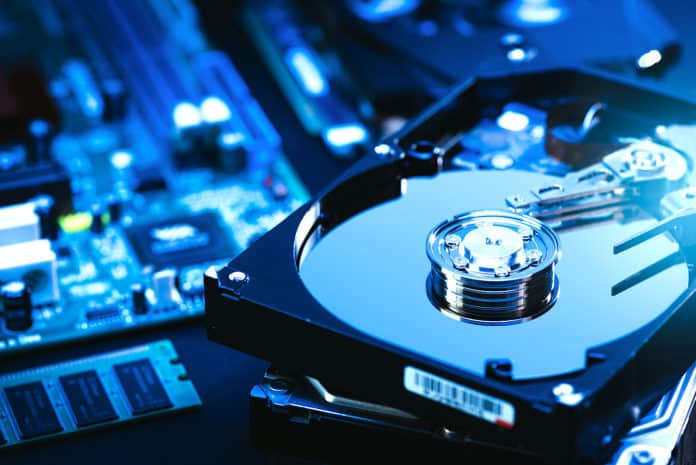RAID 5 is a data backup technology for hard disk drives that uses both disk striping and parity. It is one of the levels of RAID: Redundant Array of Independent Disks, originally Inexpensive Disks. RAID was developed in the 1980s and has multiple iterations, of which RAID 5 is just one. IBM has held the patent for RAID 5 since the 1980s.
RAID 5 Technologies
Disk Striping
Disk striping was first introduced in RAID 0, the initial version of RAID. It distributes all the data in the array across multiple disks. Disk striping quickly proved to be an unreliable backup technique, though, because if one disk failed, the data on it would be lost, and there was no way to recover the lost files.
Disk mirroring, which technology professionals often associate with RAID, is a common technique for creating disk redundancy. Data is completely copied from one disk to a second that mirrors it. RAID 5 doesn’t use disk mirroring, however; it combines disk striping and a data-checking technique called parity.
Parity
Parity ensures that data transfers correctly, since errors can cause bits from files to be lost. Parity uses bit checking, through checksums, to manage data’s safety. Disk striping does not provide a reliable backup system, but parity is designed to interpret data when it’s lost.
Disk drives that use parity are able to reconstruct missing data based on all the information from the other drives. They do it mathematically, through an XOR operation, using the information they have and what remains on the other disks to rebuild the lost data.
An array using parity will typically need about a full drive’s worth of capacity dedicated to the parity data. However, RAID 5 parity is spread among each drive, unlike RAID 4, which stores it all on one disk. This provides added security (not all parity data is lost if that drive fails). Also, a general note about disk drives is that the exact amount of room available on a disk may not be what’s advertised, because formatting RAID configurations takes some of that space.
What are Advantages of RAID 5?
RAID 5 is one of the most popular iterations of RAID. It combines two disk technologies to minimize data loss and increase read performance. Because RAID 5 uses disk striping, it has faster read speeds than other iterations of RAID. The data is spread across the drives, so the drives can be read at the same time. Though disk striping isn’t a reliable backup technology on its own, RAID 5 also uses parity to check data for accuracy and replace it when needed.
RAID 5 only requires three disk drives, so it’s a good redundancy solution for small disk arrays. It’s also one of the more inexpensive redundancy backup solutions.
What are Disadvantages of RAID 5?
RAID 5 is good for smaller arrays, but it’s not ideal for large-capacity disks or servers. Large disks in particular take a long time to write. If one disk encounters a failure, and the array uses RAID to rebuild the data, it could encounter another issue before the rewrite process has finished. RAID 5 isn’t intended to withstand more than one disk failure, so two could take the entire array down.
Disk failure is likely for HDDs, and because RAID 5 only allows for one total disk failure, it isn’t a good solution for large arrays, nor should it be the only backup solution for the files stored on the disks. Many data storage experts don’t believe RAID 5 is a good backup solution for hard drives any longer, since hard drives are susceptible to disk failure and more than one disk failure would cause data loss.
RAID 5 for SSDs
Though it’s not talked about as often, RAID 5 can be used for solid-state drives, which are non-volatile memory storage devices that are much faster than hard drives. SSDs are also less likely to fail than HDDs, and they have faster read speeds, which would make the rebuild process faster.
If using parity to rebuild data, SSDs are susceptible to a second failure for a much shorter period of time. They’re less likely to encounter multiple unrecoverable read errors (UREs) at once, while HDDs are much more likely to encounter multiple UREs in a rebuild.
The only potential problem is that when an SSD does eventually fail, it’s likely that the other one in the array will also fail around the same time if they have the same lifespan. So if you’re employing RAID 5 for your SSDs, you might want to consider using drives that aren’t the exact same age. Using different drives could cause other problems, such as compatibility issues, but drives failing at the same time could cause entire data loss.



